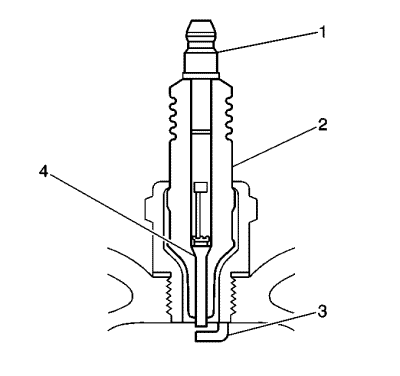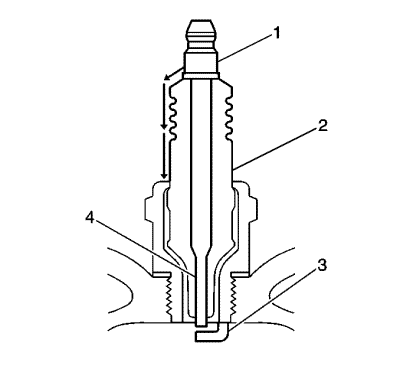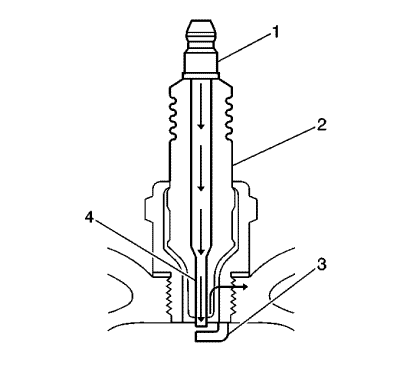Volt |
||||||||
|
|
|
|||||||
| • | Spark plug fouling--Colder plug |
| • | Pre-ignition causing spark plug and/or engine damage--Hotter plug |

| • | Inspect for a bent or broken terminal post (1). |
| • | Test for a loose terminal post (1) by twisting and pulling the post. The terminal post (1) should NOT move. |

| • | Inspect the spark plug boot for damage. |
| • | Inspect the spark plug recess area of the cylinder head for moisture, such as oil, coolant, or water. A spark plug boot that is saturated causes arcing to ground. |


| • | Measure the gap between the centre electrode (4) and the side electrode (3) terminals. Refer to Ignition System Specifications . An excessively wide electrode gap can prevent correct spark plug operation. |
| • | Inspect for the correct spark plug torque. Refer to Ignition System Specifications . Insufficient torque can prevent correct spark plug operation. An over torqued spark plug, causes the insulator (2) to crack. |
| • | Inspect for signs of tracking that occurred near the insulator tip instead of the centre electrode (4). |
| • | Inspect for a broken or worn side electrode (3). |
| • | Inspect for a broken, worn, or loose centre electrode (4) by shaking the spark plug. |
| • | Inspect for bridged electrodes (3, 4). Deposits on the electrodes (3, 4) reduce or eliminates the gap. |
| • | Inspect for worn or missing platinum pads on the electrodes (3, 4) If equipped. |
| • | Inspect for excessive fouling. |
| • | Inspect the spark plug recess area of the cylinder head for swarf. Dirty or damaged threads can cause the spark plug not to seat correctly during installation. |
| • | Rich fuel mixtures |
| • | Leaking fuel injectors |
| • | Excessive fuel pressure |
| • | Restricted air filter element |
| • | Incorrect combustion |
| • | Reduced ignition system voltage output |
| • | Weak coils |
| • | Worn ignition wires |
| • | Incorrect spark plug gap |
| • | Excessive idling or slow speeds under light loads can keep spark plug temperatures so low that normal combustion deposits may not burn off. |
| • | Deposit Fouling--Oil, coolant, or additives that include substances such as silicone, very white coating, reduces the spark intensity. Most powdery deposits will not effect spark intensity unless they form into a glazing over the electrode. |
| ©© Copyright Chevrolet. All rights reserved |